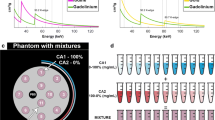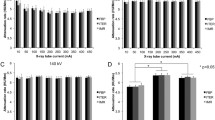Abstract
Objective
Uptake value in quantitative PET imaging is biased due to the presence of CT contrast agents when using CT-based attenuation correction. Our aim was to examine spectral CT imaging to suppress inaccuracy of 511 keV attenuation map in the presence of multiple nanoparticulate contrast agents.
Methods
Using a simulation study we examined an image-based K-edge ratio method, in which two images acquired from energy windows located above and below the K-edge energy are divided by one another, to identify the exact location of all contrast agents. Multiple computerized phantom studies were conducted using a variety of NP contrast agents with different concentrations. The performance of the proposed methodology was compared to conventional single-kVp and dual-kVp methods using wide range of contrast agents with varying concentrations.
Results
The results demonstrate that both single-kVp and dual-kVp energy mapping approaches produce inaccurate attenuation maps at 511 keV in the presence of multiple simultaneous contrast agents. In contrast, the proposed method is capable of handling multiple simultaneous contrast agents, thus allowing suppression of 511 keV attenuation map inaccuracy.
Conclusion
Attenuation map produced by spectral CT clearly outperforms conventional single-kVp and dual-kVp approaches in the generation of accurate attenuation maps in the presence of multiple contrast agents.





Similar content being viewed by others
References
Boellaard R. Standards for PET image acquisition and quantitative data analysis. J Nucl Med. 2009;50(Suppl 1):11S–20S.
Abdoli M, Dierckx RA, Zaidi H. Metal artifact reduction strategies for improved attenuation correction in hybrid PET/CT imaging. Med Phys. 2012;39(6):3343–60.
Qu M, Ehman E, Fletcher JG, Huprich JE, Hara AK, Silva AC, et al. Toward biphasic computed tomography (CT) enteric contrast: material classification of luminal bismuth and mural iodine in a small-bowel phantom using dual-energy CT. J Comput Assist Tomogr. 2012;36(5):554–9.
Aviv H, Bartling S, Grinberg I, Margel S. Synthesis and characterization of Bi2O3/HSA core-shell nanoparticles for X-ray imaging applications. J Biomed Mater Res B Appl Biomater. 2013;101(1):131–8.
Cormode DP, Roessl E, Thran A, Skajaa T, Gordon RE, Schlomka JP, et al. Atherosclerotic plaque composition: analysis with multicolor CT and targeted gold nanoparticles. Radiology. 2010;256(3):774–82.
Reuveni T, Motiei M, Romman Z, Popovtzer A, Popovtzer R. Targeted gold nanoparticles enable molecular CT imaging of cancer: an in vivo study. Int J Nanomed. 2011;6:2859–64.
Clark DP, Ghaghada K, Moding EJ, Kirsch DG, Badea CT. In vivo characterization of tumor vasculature using iodine and gold nanoparticles and dual energy micro-CT. Phys Med Biol. 2013;58(6):1683–704.
Chou SW, Shau YH, Wu PC, Yang YS, Shieh DB, Chen CC. In vitro and in vivo studies of FePt nanoparticles for dual modal CT/MRI molecular imaging. J Am Chem Soc. 2010;132(38):13270–8.
Axelsson O. Inventor contrast agents comprising tungsten-containing cores. European patent EP1893243. March 2008.
Torres AS, Bonitatibus PJ Jr, Colborn RE, Goddard GD, FitzGerald PF, Lee BD, et al. Biological performance of a size-fractionated core-shell tantalum oxide nanoparticle x-ray contrast agent. Invest Radiol. 2012;47(10):578–87.
Dekrafft KE, Boyle WS, Burk LM, Zhou OZ, Lin W. Zr- and Hf-based nanoscale metal-organic frameworks as contrast agents for computed tomography. J Mater Chem. 2012;22(35):18139–44.
Oh MH, Lee N, Kim H, Park SP, Piao Y, Lee J, et al. Large-scale synthesis of bioinert tantalum oxide nanoparticles for X-ray computed tomography imaging and bimodal image-guided sentinel lymph node mapping. J Am Chem Soc. 2011;133(14):5508–15.
Zhou J, Zhu X, Chen M, Sun Y, Li F. Water-stable NaLuF4-based upconversion nanophosphors with long-term validity for multimodal lymphatic imaging. Biomaterials. 2012;33(26):6201–10.
Pan D, Schirra CO, Senpan A, Schmieder AH, Stacy AJ, Roessl E, et al. An early investigation of ytterbium nanocolloids for selective and quantitative “multicolor” spectral CT imaging. ACS Nano. 2012;6(4):3364–70.
Liu Z, Li Z, Liu J, Gu S, Yuan Q, Ren J, et al. Long-circulating Er3+-doped Yb2O3 up-conversion nanoparticle as an in vivo X-Ray CT imaging contrast agent. Biomaterials. 2012;33(28):6748–57.
Ashokan A, Menon D, Nair S, Koyakutty M. A molecular receptor targeted, hydroxyapatite nanocrystal based multi-modal contrast agent. Biomaterials. 2010;31(9):2606–16.
Liu Y, Ai K, Lu L. Nanoparticulate X-ray computed tomography contrast agents: from design validation to in vivo applications. Acc Chem Res. 2012;45(10):1817–27.
Bulte JW. Science to practice: can CT be performed for multicolor molecular imaging? Radiology. 2010;256(3):675–6.
Ay MR, Zaidi H. Assessment of errors caused by X-ray scatter and use of contrast medium when using CT-based attenuation correction in PET. Eur J Nucl Med Mol Imaging. 2006;33(11):1301–13.
Heusner TA, Kuehl H, Veit-Haibach P, Hahn S, Boy C, Forsting M, et al. Highly iodinated intravenous contrast material for PET/CT––a feasibility study. Rofo. 2008;180(8):740–5.
Kropil P, Budach W, Bolke E, Gerber PA, Zinnmann F, Hautzel H, et al. Pitfalls in radiation oncology. “Myocardial metastasis” in PET–CT after palliative radiation treatment of the left 5th rib. Strahlenther Onkol. 2012;188(4):359–62.
McKeown C, Dempsey MF, Gillen G, Paterson C. Quantitative analysis shows that contrast medium in positron emission tomography/computed tomography may cause significant artefacts. Nucl Med Commun. 2012;33(8):864–71.
Ahmadian A, Ay MR, Bidgoli JH, Sarkar S, Zaidi H. Correction of oral contrast artifacts in CT-based attenuation correction of PET images using an automated segmentation algorithm. Eur J Nucl Med Mol Imaging. 2008;35(10):1812–23.
Nehmeh SA, Erdi YE, Kalaigian H, Kolbert KS, Pan T, Yeung H, et al. Correction for oral contrast artifacts in CT attenuation-corrected PET images obtained by combined PET/CT. J Nucl Med. 2003;44(12):1940–4.
Zaidi H, Hasegawa B. Determination of the attenuation map in emission tomography. J Nucl Med. 2003;44(2):291–315.
Kinahan PE, Alessio AM, Fessler JA. Dual energy CT attenuation correction methods for quantitative assessment of response to cancer therapy with PET/CT imaging. Technol Cancer Res Treat. 2006;5(4):319–27.
Alvarez RE, Macovski A. Energy-selective reconstructions in X-ray computerized tomography. Phys Med Biol. 1976;21(5):733–44.
Lehmann LA, Alvarez RE, Macovski A, Brody WR, Pelc NJ, Riederer SJ, et al. Generalized image combinations in dual KVP digital radiography. Med Phys. 1981;8(5):659–67.
Flohr TG, McCollough CH, Bruder H, Petersilka M, Gruber K, Suss C, et al. First performance evaluation of a dual-source CT (DSCT) system. Eur Radiol. 2006;16(2):256–68.
Zou Y, Silver MD, editors. Analysis of fast kV-switching in dual energy CT using a pre-reconstruction decomposition technique. Proceedings of the SPIE medical imaging: physics of medical imaging, San Diego, CA; 2008.
Carmi R, Naveh G, Altman A, editors. Material separation with dual-layer CT. IEEE nuclear science symposium conference record. Wyndham El Conquistador Resort, Puerto Rico: IEEE; Oct 2005. pp 23–29.
Roessl E, Cormode D, Brendel B, Jürgen Engel K, Martens G, Thran A, et al. Preclinical spectral computed tomography of gold nano-particles. Nucl Instrum Method A. 2011;648:S259–64.
Koenig T, Schulze J, Zuber M, Rink K, Butzer J, Hamann E, et al. Imaging properties of small-pixel spectroscopic x-ray detectors based on cadmium telluride sensors. Phys Med Biol. 2012;57(21):6743–59.
Le HQ, Molloi S. Segmentation and quantification of materials with energy discriminating computed tomography: a phantom study. Med Phys. 2011;38(1):228–37.
Le Huy Q, Molloi S. Least squares parameter estimation methods for material decomposition with energy discriminating detectors. Med Phys. 2011;38(1):245–55.
Roessl E, Proksa R. K-edge imaging in x-ray computed tomography using multi-bin photon counting detectors. Phys Med Biol. 2007;52(15):4679–96.
Schlomka JP, Roessl E, Dorscheid R, Dill S, Martens G, Istel T, et al. Experimental feasibility of multi-energy photon-counting K-edge imaging in pre-clinical computed tomography. Phys Med Biol. 2008;53(15):4031–47.
Schmidt TG, Pektas F. Region-of-interest material decomposition from truncated energy-resolved CT. Med Phys. 2011;38(10):5657–66.
Wang X, Meier D, Taguchi K, Wagenaar DJ, Patt BE, Frey EC. Material separation in x-ray CT with energy resolved photon-counting detectors. Med Phys. 2011;38(3):1534–46.
Lee SW, Choi YN, Cho HM, Lee YJ, Ryu HJ, Kim HJ. A Monte Carlo simulation study of the effect of energy windows in computed tomography images based on an energy-resolved photon counting detector. Phys Med Biol. 2012;57(15):4931–49.
He P, Wei B, Cong W, Wang G. Optimization of K-edge imaging with spectral CT. Med Phys. 2012;39:6572.
Leng S, Yu L, Wang J, Fletcher JG, Mistretta CA, McCollough CH. Noise reduction in spectral CT: reducing dose and breaking the trade-off between image noise and energy bin selection. Med Phys. 2011;38(9):4946–57.
Herrmann C, Engel KJ, Wiegert J. Performance simulation of an x-ray detector for spectral CT with combined Si and Cd[Zn]Te detection layers. Phys Med Biol. 2010;55(24):7697–713.
Walsh MF, Opie AMT, Ronaldson JP, Doesburg RMN, Nik SJ, Mohr JL, et al. First CT using Medipix3 and the MARS-CT-3 spectral scanner. J Instrum. 2011;6:C01095.
Riederer SJ, Mistretta CA. Selective iodine imaging using K-edge energies in computerized x-ray tomography. Med Phys. 1977;4(6):474–81.
Ghadiri H, Ay MR, Shiran MB, Soltanian-Zadeh H, Zaidi H. K-edge ratio method for identification of multiple nanoparticulate contrast agents by spectral CT imaging. Br J Radiol. 1029;2013(86):20130308.
Cranley K, Gilmore B, Fogarty G, Desponds L, Sutton D. Catalogue of diagnostic x-ray spectra and other data. IPEM report 78. 1997.
Ghadiri H, Shiran MB, Soltanian-Zadeh H, Rahmim A, Ay MR. A fast and hardware-mimicking analytic CT simulator. IEEE nuclear science symposium and medical imaging conferenc, Korea; 2013.
Gerward L, Guilbert N, Jensen KB, Levring H. WinXCom––a program for calculating X-ray attenuation coefficients. Radiat Phys Chem. 2004;71(3–4):653–4.
Abella M, Alessio AM, Mankoff DA, MacDonald LR, Vaquero JJ, Desco M, et al. Accuracy of CT-based attenuation correction in PET/CT bone imaging. Phys Med Biol. 2012;57(9):2477–90.
Lonn AHR. Evaluation of method to minimize the effect of X-ray contrast in PET-CT attenuation correction. IEEE nuclear science symposium, conference record; 2004. pp. 2220–21.
Karlo C, Lauber A, Gotti RP, Baumuller S, Stolzmann P, Scheffel H, et al. Dual-energy CT with tin filter technology for the discrimination of renal lesion proxies containing blood, protein, and contrast-agent. An experimental phantom study. Eur Radiol. 2011;21(2):385–92.
Rehfeld NS, Heismann BJ, Kupferschlager J, Aschoff P, Christ G, Pfannenberg AC, et al. Single and dual energy attenuation correction in PET/CT in the presence of iodine based contrast agents. Med Phys. 2008;35(5):1959–69.
Kadkhodayan S, Shahriari S, Treglia G, Yousefi Z, Sadeghi R. Accuracy of 18-F-FDG PET imaging in the follow up of endometrial cancer patients: systematic review and meta-analysis of the literature. Gynecol Oncol. 2013;128(2):397–404.
Lee SD, Kim SH, Kim YK, Kim C, Kim SK, Han SS, et al. (18)F-FDG-PET/CT predicts early tumor recurrence in living donor liver transplantation for hepatocellular carcinoma. Transpl Int. 2013;26(1):50–60.
Shilo M, Reuveni T, Motiei M, Popovtzer R. Nanoparticles as computed tomography contrast agents: current status and future perspectives. Nanomedicine (Lond). 2012;7(2):257–69.
Procz S, Pichotka M, Lubke J, Hamann E, Ballabriga R, Blaj G, et al. Flatfield correction optimization for energy selective X-ray imaging with Medipix3. IEEE Trans Nucl Sci. 2011;58(6):3182–9.
Singh S, Kalra MK, Do S, Thibault JB, Pien H, Connor OO, et al. Comparison of hybrid and pure iterative reconstruction techniques with conventional filtered back projection: dose reduction potential in the abdomen. J Comput Assist Tomogr. 2012;36(3):347–53.
Deak Z, Grimm JM, Treitl M, Geyer LL, Linsenmaier U, Korner M, et al. Filtered back projection, adaptive statistical iterative reconstruction, and a model-based iterative reconstruction in abdominal CT: an experimental clinical study. Radiology. 2013;266(1):197–206.
Acknowledgments
This work was supported by Tehran University of Medical Sciences under Grant 21342 and the Swiss National Science Foundation under grant SNSF 31003A-149957.
Author information
Authors and Affiliations
Corresponding author
Rights and permissions
About this article
Cite this article
Ghadiri, H., Shiran, M.B., Soltanian-Zadeh, H. et al. Derivation of attenuation map for attenuation correction of PET data in the presence of nanoparticulate contrast agents using spectral CT imaging. Ann Nucl Med 28, 559–570 (2014). https://doi.org/10.1007/s12149-014-0846-5
Received:
Accepted:
Published:
Issue Date:
DOI: https://doi.org/10.1007/s12149-014-0846-5




